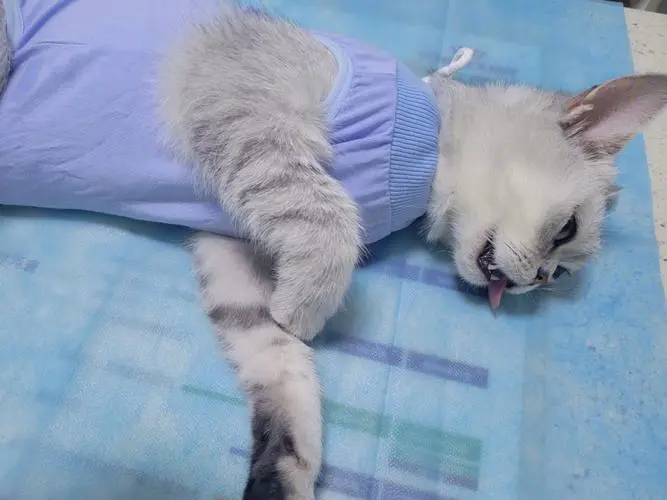Spaying your cat is an important step in ensuring their health and preventing unwanted litters. However, the recovery process post-surgery requires proper care and attention. One common concern among cat owners is how long their furry friend should wear an Elizabethan collar (also known as a cone). This comprehensive guide will cover everything you need to know about your cat’s recovery after spaying, including collar duration, post-operative care, and signs to watch for during the healing process.

1. Understanding the Spaying Procedure
What Happens During a Cat Spay Surgery?
Before diving into recovery specifics, it’s important to understand what spaying entails. The procedure involves the removal of a female cat’s ovaries and uterus, which prevents heat cycles and eliminates the risk of certain health issues such as pyometra and ovarian cancer.
- General Anesthesia: Your cat will be put under general anesthesia during the procedure.
- Surgical Process: The surgeon makes a small incision in the abdomen to remove the reproductive organs.
- Duration: The surgery typically lasts about 30 minutes to an hour, and most cats are sent home the same day.
2. Immediate Post-Operative Care
What to Expect After the Surgery
Once your cat returns home, they may still be groggy from the anesthesia. Here’s what to expect immediately post-surgery:
- Monitoring: Keep a close eye on your cat for the first 24 hours. They may exhibit signs of lethargy or mild discomfort.
- Diet: Offer a small amount of water and food. If they refuse to eat, it’s usually not a cause for concern as appetite may take time to return.
3. Elizabethan Collar: How Long Should It Be Worn?
Importance of the Elizabethan Collar
The Elizabethan collar is designed to prevent your cat from licking or biting at the surgical site, which can lead to infection or complications.
- Duration: Most veterinarians recommend keeping the collar on for at least 10 to 14 days, or until your vet gives the all-clear.
- Signs It’s Time to Remove the Collar: If your vet has confirmed that the incision is healing well, you may be able to remove the collar. Look for signs such as no redness, swelling, or discharge.
4. Caring for the Surgical Site
Post-Surgery Incision Care
Proper care of the incision site is crucial for a smooth recovery.
- Keep it Clean: Ensure the area remains clean and dry. You can gently clean around the incision with a soft, damp cloth if necessary.
- Watch for Complications: Look for any signs of infection, such as redness, swelling, or discharge. If you notice any of these signs, contact your veterinarian immediately.
5. Managing Pain and Discomfort
Pain Relief Options for Your Cat
Your veterinarian may prescribe pain relief medication to keep your cat comfortable during recovery.
- Follow Dosage Instructions: Administer medications exactly as prescribed.
- Monitor Behavior: Watch for any signs of excessive pain or discomfort, such as hiding, not eating, or vocalizing more than usual.
6. Activity Restrictions
Keeping Your Cat Calm During Recovery
Restricting your cat’s activities is essential to ensure proper healing.
- Limit Jumping and Running: Keep your cat indoors and discourage any high-energy activities for at least two weeks post-surgery.
- Create a Safe Space: Set up a quiet area with their bed, litter box, and food to help them feel comfortable.
7. Nutrition After Surgery
Feeding Your Cat for Optimal Recovery
Nutrition plays a significant role in recovery after spaying.
- Quality Diet: Offer high-quality cat food that provides the necessary nutrients to aid healing.
- Hydration: Ensure your cat has access to fresh water at all times. Dehydration can hinder recovery.
8. Follow-Up Appointments
Importance of Vet Check-Ups
Post-operative check-ups are vital for assessing your cat’s healing process.
- Schedule a Follow-Up: Make an appointment for a week or two after the surgery to allow your vet to check the incision site and ensure there are no complications.
- Discuss Concerns: Bring up any concerns or observations you have about your cat’s behavior or healing during the visit.
9. Behavioral Changes Post-Surgery
What Changes to Expect After Spaying
Your cat may exhibit different behavior after spaying due to hormonal changes and the effects of surgery.
- Calmer Demeanor: Many owners notice that their cats become less aggressive or territorial after being spayed.
- Appetite Changes: Your cat may have an increased appetite post-surgery. Monitor their food intake and adjust portions to maintain a healthy weight.
10. Conclusion: A Smooth Recovery Journey
The recovery process after spaying is crucial for your cat’s health and well-being. Understanding how long your cat should wear an Elizabethan collar, how to care for the surgical site, and recognizing signs of complications can ensure a smooth recovery. Always consult your veterinarian with any questions or concerns during this period. Your attention and care will significantly contribute to your cat’s health and happiness after surgery.

Comments (0)